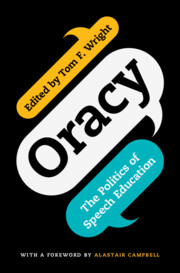Refine search
Actions for selected content:
276 results
1 - The Historiographical Context
- from Part I - The Selbstzeugnisse in Context
-
- Book:
- Making Merchants
- Published online:
- 19 September 2025
- Print publication:
- 09 October 2025, pp 9-17
-
- Chapter
- Export citation
20 - Liturgical Texts
- from Part V - The Study of Liturgy
-
-
- Book:
- The Cambridge Companion to Christian Liturgy
- Published online:
- 19 September 2025
- Print publication:
- 09 October 2025, pp 355-368
-
- Chapter
- Export citation
Chapter 8 - Meaning-making with children: Semiotics, learning and communicating
-
-
- Book:
- The Arts and Meaning-Making with Children
- Published online:
- 11 September 2025
- Print publication:
- 25 September 2025, pp 163-187
-
- Chapter
- Export citation

Oracy
- The Politics of Speech Education
-
- Published online:
- 23 September 2025
- Print publication:
- 31 July 2025
Chapter 14 - Using picture books to develop language and literacies in HASS
- from Part III - Teaching and learning in HASS
-
-
- Book:
- Making Humanities and Social Sciences Come Alive
- Published online:
- 02 August 2025
- Print publication:
- 14 August 2025, pp 236-250
-
- Chapter
- Export citation
Chapter 6 - Elementary School Adjustment
-
- Book:
- School Adjustment
- Published online:
- 29 August 2025
- Print publication:
- 07 August 2025, pp 132-187
-
- Chapter
- Export citation
Chapter 2 - Why the Arts are fundamental
- from Part 1 - Why: the arts in education and society
-
- Book:
- Teaching the Arts
- Published online:
- 28 July 2025
- Print publication:
- 06 August 2025, pp 31-63
-
- Chapter
- Export citation
20 - Literacies for Teaching
- from Part V - Practice
-
-
- Book:
- The Cambridge Handbook of Technology in Language Teaching and Learning
- Published online:
- 15 June 2025
- Print publication:
- 26 June 2025, pp 332-347
-
- Chapter
- Export citation
Chapter 11 - Developing writing
- from Part 2 - Developing language and literacy
-
-
- Book:
- Language and Literacy
- Published online:
- 29 May 2025
- Print publication:
- 12 June 2025, pp 240-261
-
- Chapter
- Export citation
Chapter 9 - Developing oracy
- from Part 2 - Developing language and literacy
-
-
- Book:
- Language and Literacy
- Published online:
- 29 May 2025
- Print publication:
- 12 June 2025, pp 197-218
-
- Chapter
- Export citation
Chapter 3 - Morphological awareness
- from Part 1 - Language and literacy fundamentals
-
-
- Book:
- Language and Literacy
- Published online:
- 29 May 2025
- Print publication:
- 12 June 2025, pp 51-70
-
- Chapter
- Export citation
Chapter 8 - Teaching text types and grammar
- from Part 2 - Developing language and literacy
-
-
- Book:
- Language and Literacy
- Published online:
- 29 May 2025
- Print publication:
- 12 June 2025, pp 176-196
-
- Chapter
- Export citation
Chapter 12 - Developing critical literacy
- from Part 2 - Developing language and literacy
-
-
- Book:
- Language and Literacy
- Published online:
- 29 May 2025
- Print publication:
- 12 June 2025, pp 262-286
-
- Chapter
- Export citation
Chapter 4 - Grammar
- from Part 1 - Language and literacy fundamentals
-
-
- Book:
- Language and Literacy
- Published online:
- 29 May 2025
- Print publication:
- 12 June 2025, pp 71-109
-
- Chapter
- Export citation
Chapter 2 - Phonemic awareness
- from Part 1 - Language and literacy fundamentals
-
-
- Book:
- Language and Literacy
- Published online:
- 29 May 2025
- Print publication:
- 12 June 2025, pp 31-50
-
- Chapter
- Export citation
Introduction
-
- Book:
- Language and Literacy
- Published online:
- 29 May 2025
- Print publication:
- 12 June 2025, pp 1-6
-
- Chapter
- Export citation
Chapter 5 - Social use of language
- from Part 1 - Language and literacy fundamentals
-
-
- Book:
- Language and Literacy
- Published online:
- 29 May 2025
- Print publication:
- 12 June 2025, pp 110-133
-
- Chapter
- Export citation
Chapter 6 - English language diversity and change
- from Part 1 - Language and literacy fundamentals
-
-
- Book:
- Language and Literacy
- Published online:
- 29 May 2025
- Print publication:
- 12 June 2025, pp 134-152
-
- Chapter
- Export citation
Chapter 1 - Phonological awareness
- from Part 1 - Language and literacy fundamentals
-
-
- Book:
- Language and Literacy
- Published online:
- 29 May 2025
- Print publication:
- 12 June 2025, pp 9-30
-
- Chapter
- Export citation
Chapter 7 - Developing vocabulary
- from Part 2 - Developing language and literacy
-
-
- Book:
- Language and Literacy
- Published online:
- 29 May 2025
- Print publication:
- 12 June 2025, pp 155-175
-
- Chapter
- Export citation
